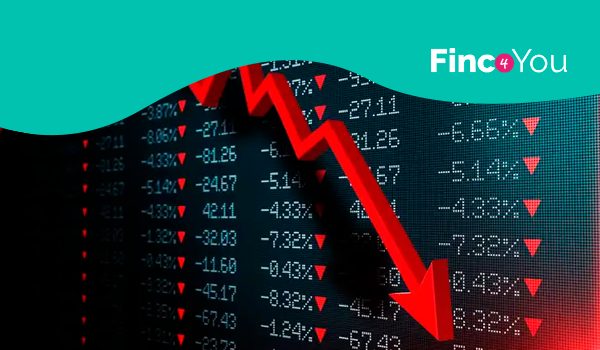
While bond investments are often considered to be less risky than their stock counterparts, they are still subject to market crashes that can have devastating effects on portfolios. With recent events causing concern over the stability of the bond market, it’s important to have a plan in place for surviving a crash. In this guide, we’ll take a deeper look at the bond market and explore strategies for minimizing risk and maximizing returns.
From understanding the different types of bonds to diversifying your portfolio, we’ll walk you through the steps you need to take to survive a bond market crash. So whether you’re a seasoned investor or just starting out, read on to learn how to weather the storm of a bond market crash.
Signs of an impending bond market crash
The bond market, often regarded as a haven of stability and predictability, plays a pivotal role in the global economy, providing essential financing for governments, corporations, and institutions.
However, beneath the facade of tranquility, signs of vulnerability may lurk, signaling a potential upheaval in bond markets worldwide.
As investors navigate through a landscape of low interest rates, rising inflationary pressures, and evolving central bank policies, identifying the warning signs of an impending bond market crash becomes paramount.
In this comprehensive article, we delve into the intricacies of bond market dynamics, examining the key indicators that could herald a market downturn. By understanding these signs and their implications, investors can better position themselves to manage risks and safeguard their portfolios against potential disruptions.
- Inverted Yield Curve
One of the most reliable indicators of an impending bond market crash is an inverted yield curve. This phenomenon occurs when short-term interest rates exceed long-term rates, reflecting market expectations of economic contraction.
Historically, inverted yield curves have preceded many recessions and bear markets, signaling a potential flight to safety among investors and a downturn in bond prices.
- Rising Interest Rates
The trajectory of interest rates is a critical determinant of bond market performance. A sustained increase in interest rates, driven by monetary tightening or inflationary pressures, can erode the value of existing bonds, leading to capital losses for investors.
Rising rates also raise borrowing costs for governments and corporations, potentially straining their ability to service debt and triggering a sell-off in bond markets.
- Credit Spreads Widening
Widening credit spreads, or the difference in yields between risk-free government bonds and higher-risk corporate bonds, can signal deteriorating credit conditions and investor concerns about default risk.
An increase in credit spreads suggests a flight to quality, with investors demanding higher compensation for bearing credit risk. In extreme cases, widening spreads may precipitate a broader sell-off in bond markets, particularly in sectors facing heightened credit stress.
- Central Bank Policy Shifts
Central bank policies play a crucial role in shaping bond market dynamics, influencing interest rates, inflation expectations, and investor sentiment.
Any unexpected shifts in monetary policy, such as aggressive interest rate hikes or abrupt changes in asset purchase programs, can roil bond markets and trigger volatility.
Moreover, divergent policy actions among major central banks may exacerbate global bond market tensions, amplifying contagion risks across regions.
- Liquidity Deterioration
Bond market liquidity, or the ease with which investors can buy or sell bonds without significantly impacting prices, is essential for market functioning and stability.
A deterioration in liquidity conditions, characterized by widening bid-ask spreads, reduced market depth, and heightened volatility, can exacerbate selling pressure during periods of market stress. Illiquidity may impede investors’ ability to exit positions swiftly, exacerbating losses and amplifying market dislocation.
- Geopolitical Risks and Uncertainties
Geopolitical events, such as trade tensions, geopolitical conflicts, or sovereign debt crises, can inject uncertainty into bond markets, prompting investors to reassess risk exposures and asset allocations.
Heightened geopolitical risks may trigger safe-haven demand for government bonds, leading to yield compression and heightened volatility.
Conversely, geopolitical developments with adverse economic implications may weigh on investor sentiment, fueling risk aversion and driving up bond yields.
- Market Sentiment and Investor Behavior
Market sentiment and investor behavior often play a significant role in shaping bond market dynamics, influencing supply-demand dynamics and price movements. Excessive optimism or pessimism among investors can lead to speculative bubbles or panic selling, exacerbating market volatility and amplifying downside risks.
Monitoring indicators of investor sentiment, such as fund flows, positioning data, and sentiment surveys, can provide valuable insights into market sentiment and potential inflection points.
As investors navigate through a complex and interconnected global financial system, staying vigilant to the signs of an impending bond market crash is essential for managing risks and preserving capital.
While bond markets have historically been characterized by resilience and stability, underlying vulnerabilities and structural imbalances may heighten the potential for market dislocation and volatility.
By closely monitoring key indicators such as the yield curve, interest rates, credit spreads, central bank policies, liquidity conditions, geopolitical risks, and investor sentiment, investors can better position themselves to navigate turbulent market conditions and seize opportunities amidst uncertainty.
Additionally, adopting a diversified investment approach, incorporating risk management strategies, and maintaining a long-term perspective can help mitigate the impact of bond market volatility and safeguard portfolio resilience in the face of adversity.
Preparing for a bond market crash

Preparing for a potential bond market crash is crucial for investors who want to safeguard their assets and minimize risks during turbulent times. One key strategy is diversification. By spreading investments across different asset classes, such as stocks, bonds, real estate, and commodities, investors can reduce their exposure to any single market downturn.
Another important consideration is to review the quality of the bonds in your portfolio. Higher quality bonds issued by stable governments or corporations may be less affected by a market crash compared to lower-grade bonds with higher default risks.
Assessing the creditworthiness of bond issuers and considering bonds with shorter maturities can also help mitigate potential losses.
Furthermore, having a well-thought-out investment strategy and sticking to a long-term plan can help investors navigate market volatility without making knee-jerk reactions.
Establishing clear goals, risk tolerance, and a diversified portfolio aligned with your financial objectives can provide a solid foundation to weather the storm of a bond market crash.
Finally, staying informed about market trends, economic indicators, and global events that could impact bond markets is essential for making informed decisions. Seeking advice from financial professionals or bond market experts can provide valuable insights and guidance on how to prepare for and respond to a potential market downturn.
By taking proactive steps to prepare for a bond market crash, investors can position themselves more effectively to protect their investments and navigate challenging market conditions.
Long-term strategies to safeguard against future crashes
In times of market volatility and uncertainty, having long-term strategies in place to safeguard your investments is crucial. While it’s impossible to predict when the next bond market crash will occur, there are steps you can take to prepare and protect your portfolio.
One effective strategy is diversification. By spreading your investments across a range of asset classes, industries, and geographic regions, you can reduce the impact of a bond market crash on your overall portfolio.
Diversification can help minimize risk and protect your investments from sudden market downturns. Another key long-term strategy is to focus on high-quality investments. During periods of market turbulence, investors tend to flock to safe-haven assets such as U.S. Treasury bonds.
By investing in high-quality bonds issued by stable governments or reputable corporations, you can help shield your portfolio from the worst effects of a market crash.
Final thoughts
In times of financial turbulence, knowledge is power. We hope that our guide on surviving a bond market crash has provided you with valuable insights and strategies to navigate through challenging times.
Remember, staying informed, diversifying your investments, and maintaining a long-term perspective are key components to weathering the storm. By following the tips outlined in this blog post, you can better prepare yourself and your portfolio for any future market uncertainties. Stay resilient, stay informed, and stay focused on your financial goals.


